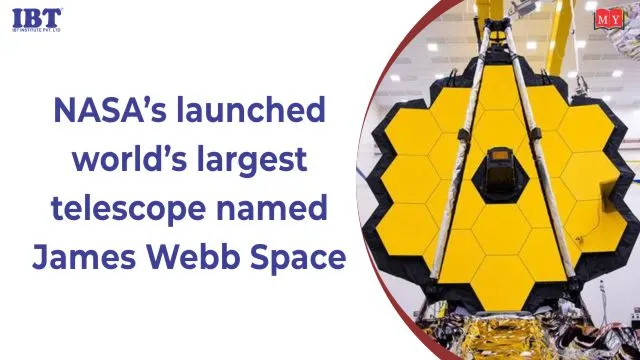
NASA’s launched world’s largest telescope named James Webb Space
The world’s largest and most powerful space telescope rocketed away 25th December on a high-stakes quest to behold light from the first stars and galaxies and scour the universe for hints of life.
NASA's James Webb Space Telescope soared from French Guiana on South America’s northeastern coast, riding a European Ariane rocket into the Christmas morning sky.
The $10 billion observatory hurtled toward its destination 1 million miles (1.6 million kilometers) away, or more than four times beyond the moon. It will take a month to get there and another five months before its infrared eyes are ready to start scanning the cosmos.
First, the telescope’s enormous mirror and sunshield need to unfurl; they were folded origami-style to fit into the rocket's nose cone. Otherwise, the observatory won’t be able to peer back in time 13.7 billion years as anticipated, within a mere 100 million years of the universe-forming Big Bang.
Intended as a successor to the aging Hubble Space Telescope, the long-delayed James Webb is named after NASA’s administrator during the 1960s. NASA partnered with the European and Canadian space agencies to build and launch the new 7-ton telescope, with thousands of people from 29 countries working on it since the 1990s.
With the launch falling on Christmas and a global surge in COVID-19 cases, there were fewer spectators at the French Guiana launch site than expected. Nelson bowed out along with a congressional delegation and many contractors who worked on the telescope.
Around the world, astronomers had eagerly waited to see Webb finally taking flight after years of setbacks. Last-minute technical snags bumped the launch nearly a week, then gusty wind pushed it to Christmas. Inside Launch Control, there was a smattering of Santa hats.
The telescope's showpiece: a gold-plated mirror more than 21 feet (6.5 meters) across.
Protecting the observatory is a wispy, five-layered sunshield, vital for keeping the light-gathering mirror and heat-sensing infrared detectors at subzero temperatures. At 70 feet by 46 feet (21 meters by 14 meters), it’s the size of a tennis court.
If all goes well, the sunshield will be opened three days after liftoff, taking at least five days to unfold and lock into place. Next, the mirror segments should open up like the leaves of a drop-leaf table, 12 days or so into the flight.
In all, hundreds of release mechanisms need to work — perfectly — in order for the telescope to succeed. “Like nothing we’ve done before,” said NASA program director Greg Robinson.
Retired astronaut-astronomer Steven Hawley is more stressed over Webb than he was for Hubble, which he released into orbit from space shuttle Discovery in 1990. That’s because Webb will be too far away for rescuing, as was necessary when Hubble turned out to have blurry vision from a defective mirror.
Spacewalking repairs by astronauts transformed Hubble into a beloved marvel that has revolutionized humanity’s understanding of the universe, casting its eyes as far back as 13.4 billion years. It’s now up to Webb to draw even closer to the Big Bang 13.8 billion years ago, its infrared vision keener and more far-reaching than Hubble’s is in the shorter visible and ultraviolet wavelengths.
NASA is shooting for 10 years of operational life from Webb. Engineers deliberately left the fuel tank accessible for a top-off by visiting spacecraft, if and when such technology becomes available.
About James Webb Space Telescope (JWST or Webb)
JWST has been in the works for decades. It has been jointly developed by NASA, Canadian Space Agency (CSA) and the European Space Agency (ESA). As NASA’s flagship astrophysics mission, it is planned to succeed the Hubble Space Telescope. It launched on December 25, 2021 during Ariane flight VA256. The primary mirror of JWST that is, Optical Telescope Element, comprises of 18 hexagonal mirror segments. These segments are made up of gold-plated beryllium.
Purpose of the Mission
JWST mission will provide improved infrared resolution and sensitivity as compared to Hubble Space Telescope. It will enable a broad range of investigations in the fields of astronomy & cosmology, including observation of some of most distant events and objects in space, like formation of the first galaxies and detailed atmospheric characteristics of potentially habitable exoplanets.
Ariane flight VA256
It is the 256th Ariane mission. This mission will launch the James Webb Space Telescope into space. Ariane 5 is a heavy lift two-stage rocket comprising of two solid fuel boosters. The rocket used in its ECA variant, offering the highest payload mass capacity. Total launch mass of the vehicle is around 770,000 kg. Its only payload is the James Webb Space Telescope (JWST). This launch is one of the contributions of European Space Agency.
 4.5/5
4.5/5








